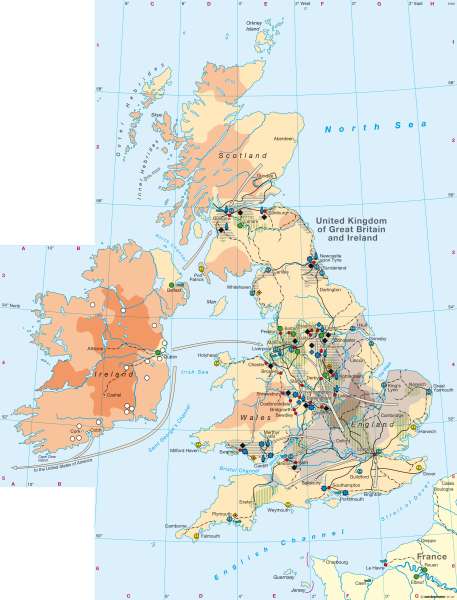Industrialization in the 19th century
British Isles - History and economy
978-3-14-100790-9 | Page 66 | Ill. 1

Information
The map of industrialization in Great Britain in the 19th century shows a wide range of factors that influenced the course of industrialization or were influenced by it. Firstly it shows the reserves of mineral resources and the structure of industry that partly depended on them. Secondly the key transport facilities are illustrated. And thirdly the map contains information on population movements.Mineral Resources and Industry
An important prerequisite for the early onset of industrialization in Great Britain was its rich reserves of coal as an energy source. The largest reserves were located — from north to south — between Edinburgh and Glasgow, along the coast between Carlisle and Whitehaven as well as around Newcastle upon Tyne, in Central England, marked by the cities of Manchester, Sheffield and Birmingham, and finally north of Cardiff and south of Bristol. Central England in particular also possessed iron ore as well as lead and zinc, so that one of Europe's most important centres of heavy industry was able to establish itself there.
The textile industry, which developed into one of the key industries of the 19th century, experienced a boom due to inventions such as the power loom as well as the import of cotton as raw material from the colonies. Traditional cottage industry made way for large factories. The most significant centres of this industry were at New Lanark in Scotland, which became a UNESCO World Heritage Site in 2001, as well as Leeds, Manchester and Nottingham.
Transport
Transporting the masses of raw materials on the one hand and finished products on the other required more effective means of transport and routes than had existed until the 18th century. A first step was the expansion of the canals up till the early 19th century, among other things giving Central England a link to the Thames and thus to London, where cargoes were trans-shipped.
More decisive however was the invention of the steam locomotive and the consequent rapid expansion in the railway network. In the early stages, up to 1836, the industrial centres were connected with one another. Later lines were added to provide through connections from north to south as well as links to the ports for import and export which — where they did not already exist — developed all around the coast.
Population
The population of Great Britain rose continuously from the middle of the 18th century onwards. In 1750 it was still significantly below 10 million, but a century later it had already passed the 25 million mark, and in the year 1900 it reached more than 40 million. This was made possible, among other things, by improved nutrition and better hygiene conditions. But there were also reversals. The Great Famine in Ireland in the 1840s cost hundreds of thousands of lives. Many other Irish people lost their means of subsistence and had no choice but to emigrate. Their principal destination was the USA, but many also moved to the economically prosperous England. Also within England, Scotland and Wales, many people turned their backs on rural life to seek their fortune in the industrial centres. In the second half of the 19th century, for example, large areas of Scotland lost up to half of their population.
D. Falk; Ü: J. Attfield




